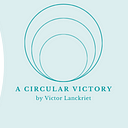Teemill: analysing a Circular business case
Hi everyone and welcome to the 15th blog post of A Circular Victory. Last week we analysed the business case of reusable and recyclable takeaway containers. We did this based on the Circular strategies and business models.
This week, we are going to analyse a business model again, but we are going to zoom in on a specific company! The company is called: Teemill.
Teemill
So what does Teemill do? At the basis, they produce and print clothing. But they do more than that. They have opened up a platform that allows other brands to use their processes and services to produce circular and sustainable t-shirts. In short, they have made an open-access circular supply chain for fashion. Now, what processes do they apply to be sustainable?
They work with 100% renewable energy, they use organic cotton and they make new t-shirts out of old ones. They have a very strong focus on circularity throughout their processes too. An example of this is the wastewater. They make an effort to recycle the water that is used to dye fabrics. They do this by filtering the wastewater through reverse osmosis and distillation. This process results in two resources: clean water and dirty mulch. The clean water is used again for the next batch, whereas the mulch is left to dry and can be used for road markings.
These examples are just a few of the many efforts they make to be as Circular as they possibly can be! Now that we have the background on Teemill as a company, let’s analyse them based on our 5 Rs and the Circular business models.
The Circular Strategies
As a quick reminder, there are five Circular strategies, also known as the 5 Rs of the Circular Economy. These 5 Rs are Reduce, Reuse, Refurbish, Repair and Recycle. If you want a deeper explanation of these 5 strategies, you can find them in the second post of this podcast.
In this business, we are not seeing much reducing, but we are seeing intense examples of reusing and recycling. Let’s look at each of these strategies individually.
Reusing
This is maybe the most used strategy in this company. We see it coming back throughout their whole business. Firstly, they actively reuse the t-shirts they make. They have developed a take-back management model so that used t-shirts can be returned to the facility. There they can wash the graphics out of the t-shirt and reuse it if it’s still in a good enough shape. If not, it gets moved to the recycling pile.
Recycling
There is also a lot of recycling going on in the Teemill process. The first is in their t-shirts. Because Teemill is committed to using 100% organic cotton, they can recycle the t-shirts that come back to them when they are not in good enough shape to just be reused.
The wastewater that comes from dyeing the t-shirts is also recycled. As described earlier, the wastewater is filtered through reverse osmosis and distillation. The water can then be used again in the dyeing process. This greatly reduces the water needed to make their shirts.
These are just two examples of recycling in the Teemill process. However, because they are strongly committed to Circularity, we find examples of recycling throughout all their processes.
In the Teemill business model, the borders between reusing and recycling can sometimes get faded a bit. The best example is their water usage. The process of filtering the water can be seen as recycling, but in the end, it is the very same water that gets used in the dyeing process over and over again. In a strong Circular business, that can sometimes happen. The 5 Rs can be seen as a spectrum, rather than 5 strongly distinct steps.
The Circular Business models
As a quick refresher, there are five basic Circular business models spread throughout the supply chain, as can be seen in the image below. These business models are Circular Inputs, Resource Recovery, Product Use Extension, Sharing Platforms and Resource Recovery.
In Teemill, we’re mainly seeing two business models: Circular Inputs and Resource Recovery. These two business models are closely interrelated. We can easily showcase this interrelation by looking at the use of natural cotton in the Teemill business.
Teemill makes a big effort to only use 100% natural cotton in their t-shirts. Natural cotton allows the product to be recycled at the end of its lifecycle. In a linear economy, we are used to seeing different companies carrying out these different tasks. With Teemill it is different. In true Circular fashion, they organise ways for their old t-shirts to find their way back to them. They then reuse or recycle those t-shirts and can provide themselves with the Circular Inputs needed for their product.
